Suppose Java did not provide a square root procedure. Could we build one ourselves?

The mathematical definition of the problem is:
Given x>0, find y such that y2=x.This tells us what we want but not how to get it. We need an algorithm.
Think back to what you did when you first learned to find square roots. Recall that if y is the square root of x, then y2=x, so x/y=y. This gives us an idea for an algorithm:
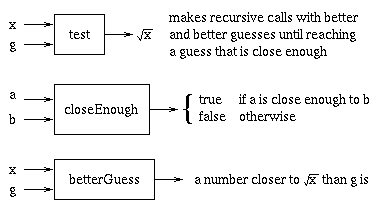
Then, to solve the square root problem, we can reduce it to
test:
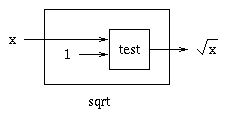
double sqrt(double x) {
return test(x, 1);
}
Note: We have defined sqrt in terms of
test, but we have not yet defined
test. We just have its specification, and have
deferred its implementation. In other words, we have treated it
as a black box to be filled in later.
Doing top down refinement -- decomposing a problem into
smaller problems that can be filled in later -- is helpful in
the algorithm design and implementation process because it
saves you from thinking about all the details at once.
test: If x / g is close to
g, return g, return g. Otherwise, try a
better guess.
double test(double x, double g) {
if closeEnough(x/g, g)
return g;
else
return test(x, betterGuess(x, g));
}
We haven't even really thought about
closeEnough or betterGuess yet. Now
it's time to fill those in.
closeEnough: returns true iff a is "close"
to b.
This is a vague specification. Let's define "close" to mean within .001 of each other.
boolean closeEnough(double a, double x) {
return (Math.abs(a - b) < .001);
}
betterGuess: returns a value closer to the square
root of x than g is.If x / g is not close enough to g, how can we bring them closer? We can choose a new guess that is the average of x / g and g.
double betterGuess(double x, double g) {
return ((g + x/g) / 2);
}
Now we have the whole implementation. We reduced
sqrt to test, and then filled in
closeEnough and betterGuess. Let's
try an example:
sqrt(2) |
Guess g |
x / g |
New guess, (g + x /
g) / 2 |
test(2, 1) |
1 | 2 / 1 = 2 | (2+1)/2 = 1.5 |
test(2, 1.5) |
1.5 | 2 / 1.5 = 1.3333 | (1.3333+1.5)/2 = 1.4167 |
test(2, 1.4167) |
1.4167 | 2 / 1.4167 = 1.4118 | (1.4167+1.4118)/2 = 1.4142 |
test(2, 1.4142) |
1.4142 | ... |
test is called
to see how it converges.To summarize, some advantages of black box abstraction and top down refinement in algorithm design and implementation include:

For example, suppose we try sqrt(.000001).
If our solution is only within .001 of the square root,
.001, this is close to useless. Maybe we can be more
clever about closeEnough.
Suppose we modify closeEnough(a, b) to return
true iff a and b differ by a
small percentage. (Note that this also helps us stop
earlier on large square roots.)
boolean closeEnough(double a, double b) {
return (Math.abs(a - b) < (b * 0.001)); // a is within 0.1% of b
}
We just replace the definition of closeEnough.
We don't have to change any of the other procedures.
Math.sqrt
method. But what if we want to take cube roots or fourth roots?
Let's develop an algorithm.We want, for some n, to have a box

In other words, we want to find x such that xn = w. Rewriting, xn - w = 0.
Therefore, if f(x) = xn - w, we want to find the value of x where f(x) = 0, that is, where the curve crosses the x-axis.
So the question becomes more general: For a given function f(x), how do we find the place where the curve crosses zero? We could solve this by guessing values as before and trying better guesses until we reach the solution. But which guesses do we try in order to reach the solution quickly?
To simplify the problem, let's assume that f(x) over the interval of interest
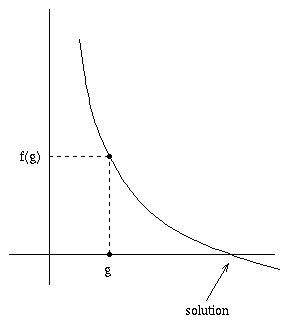
Let's suppose we start by guessing g. If we could somehow use the general "direction" of the curve to guide us, it could lead us to a better guess.
The derivative provides us with exactly that. The derivative f'(g) gives us the slope of the curve at g, so we can find a new guess closer to the solution by determining where the line passing through f(g) with slope f'(g) crosses the x-axis.
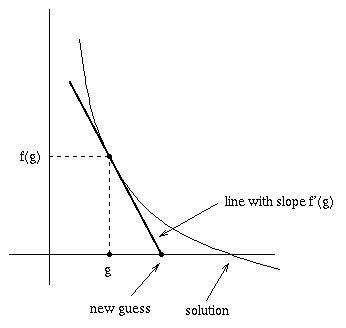
Then we do it again:
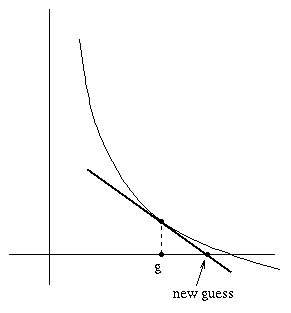
until we get close enough to the final solution. This is known as Newton's method.
So two details remain:
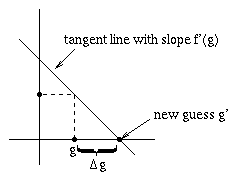
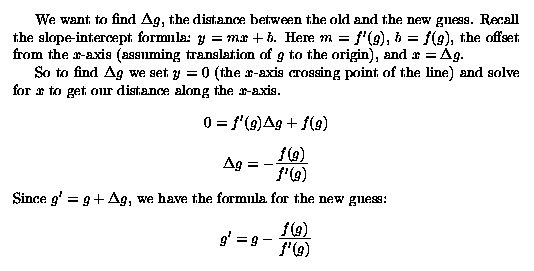
Determining When We're Close Enough
We can do the same thing we did for the square root algorithm
-- see if the old and new guesses are within a small percentage
of each other.
Putting it All Together
Let's build a RootFinder class whose constructor takes
a single parameter n and creates an object that can
be used to find nth roots. What methods will be
needed inside the RootFinder?
Public methods:
root that takes in
a double w and returns the nth root of
w.
findRoot(w, g) -- finds the nth root
of w, starting from guess g.
f(w, g) -- evaluates f(g) =
gn - w.
fPrime(w, g) -- evaluates
f'(g) = ngn-1.
closeEnough(a, b) -- returns true iff
a is "close" to b.
import cs101.terminal.*;
public class RootFinder {
int n;
RootFinder(int n) {
this.n = n;
}
double f(double w, double g) {
return (Math.pow(g,n) - w);
}
double fPrime(double g) {
return (n * Math.pow(g, n-1));
}
boolean closeEnough(double a, double b) {
return (Math.abs(a-b) < Math.abs(b * 0.0001));
}
double findRoot(double w, double g) {
Terminal.println(" guessing " + g);
double newGuess = g - f(w,g) / fPrime(g);
if (closeEnough(newGuess, g))
return newGuess;
else
return findRoot(w, newGuess);
}
public double root(double w) {
return findRoot(w,1);
}
}